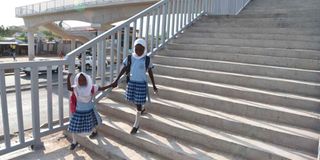Turkana County uses devolution funds to rewrite its story

Children use a footbridge in Lodwar town, Turkana County, on September 16, 2021.
Legend has it that when Turkana people travelled outside their expansive county, they would teasingly say ‘I am coming from Lodwar, going to Kenya,’ suitably describing how harsh life must have been there.
For long, the county has been glaringly known for depressing images of devastating hunger, neglected dusty roads and run-down government facilities, leading to poor service delivery.
And coupled with local and cross-border cattle rustling and banditry, high poverty levels and years of systemic marginalisation, the county was literally ‘cut off’ from the rest of the country before devolution.
The near desert-like county is one of the poorest regions in the country, with high illiteracy. A tale has it that errant civil servants were in the past posted to then-Turkana district on disciplinary grounds. And due to its hardship, it was as if they were being punished rather than serving the population, further marginalising the region.
At 13 per cent of Kenya’s land mass, poverty levels in Turkana stand at 79.4 per cent, according to the Kenya-Economic Report of 2020 by the Kenya Institute for Public Policy Research and Analysis, way above the national average of 31.6 per cent. The report says the county has the highest number of hardcore poor (571,000 individuals), accounting for 15 per cent of the total hardcore poor in the country.
Peri-urban areas
In the KIHBS 2015/16 Well-being Report, a household is in hardcore or extreme poverty if their monthly adult equivalent total consumption expenditure per person is less than Sh1,954 in rural and peri-urban areas and less than Sh2,551 in core-urban areas.
According to the Kenya National Bureau of Statistics and the Society for International Development, Turkana leads with 82 per cent illiteracy levels, followed by Wajir, Garissa, Mandera and Marsabit at 76 per cent, 74 per cent, 70 per cent and 68 per cent respectively. The illiteracy is due to inadequate education facilities, low teacher-to-pupil ratios, low enrolments and low retention and transition rates. But thanks to devolution, a lot of these stories are being changed, with gains in many fields.
For example, a decade ago, Lodwar town, the administrative town of the county, was reputed as a remote region detached from the rest of Kenya. The picturesque of the region is now a complete contrast of it was.
Thanks to devolution, the town has expanded, gaining commercial and economic status. The once dilapidated dusty roads have now been tarmacked, with skyscrapers dotting the town and booming business recorded.
Mr James Eyoko, a retailer in Lodwar town, says locals had been isolated and neglected for a long time and it explains why when they visited other regions, they would say they were going to Kenya. “For a fact, this was a closed district. When there is neglect in every sector, coupled with the harsh climatic condition, locals suffer to a point they feel isolated from the rest of the country,” he says.
He says everything was being transported by road and the security situation between Lodwar and Kitale was bad.
“Vehicles had to travel under armed police escort and we would spend even three days on the road because it was dilapidated. But not anymore. The highway has now been tarmacked, so there is faster movement of people and goods and security has considerably improved,” he notes.
He says devolution has been like the second independence for residents. “Locals had little connection with the government because of underdevelopment, high poverty levels, and acute child mortality, among other challenges they faced.”
Turkana Kenya National Chamber of Commerce and Industry chairman Pius Ewoton says the region has experienced tremendous growth since the advent of devolution. “Lodwar is steadily gaining prominence as the northwestern economic hub. The highway linking Kenya, Uganda, South Sudan and Ethiopia passes through Lodwar town. Devolution has seen the town expand,” he states.
Housing improvement
He says with oil discovery and housing improvement, the population within Lodwar town is approaching 100,000 people.
“The banking sector has increased from one bank in 2012 to more than six commercial banks currently. The hotel industry has also had remarkable growth, with the town boosting of several three star hotels.”
Mr Ewotom notes that thousands of tourists, both local and international, flock to the region to visit different attraction sites, with daily flights between Lodwar, Eldoret and Nairobi.
Turkana director of trade James Lokwale said licensed business has increased by tenfold since devolution came into being. “We had only less than a thousand licensed businesses, which have since increased to over 10,000, ranging from retail, wholesale, hotel to accommodation. There was a mini-supermarket, but at the moment, there are 10 supermarkets.”
Governor Josphat Nanok says in 2013 when the county came into being, residents welcomed their “independence. By then, 95 per cent of the entire population lived below the poverty line. All social welfare indicators were negative, exacerbated by severe perennial famine and drought. In the first term, we invested in infrastructural development to support growth.”





